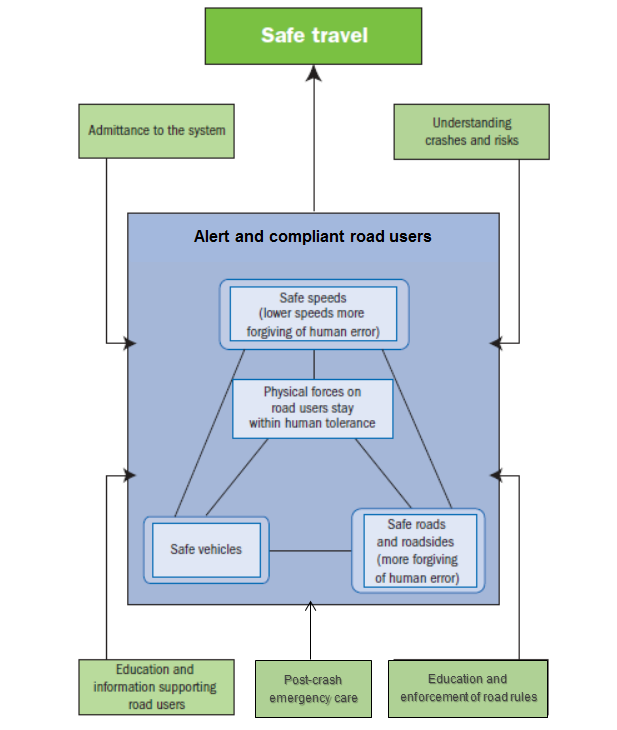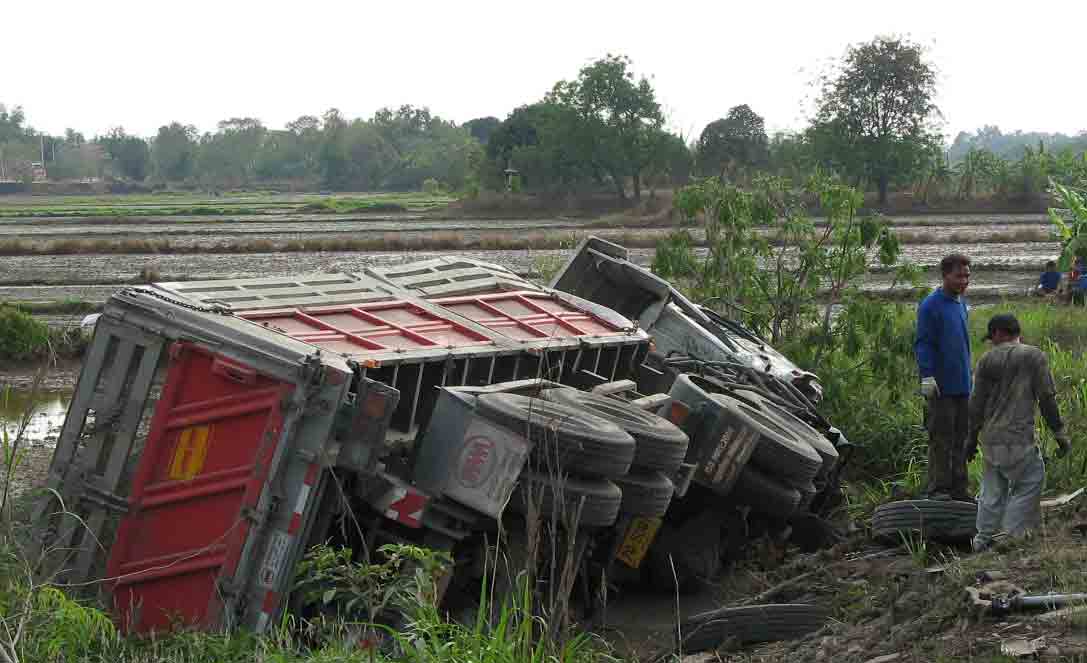
Road Safety Manual
A manual for practitioners and decision makers
on implementing safe system infrastructure!

Road Safety Manual
A manual for practitioners and decision makers
on implementing safe system infrastructure!
The Safe System approach marks a shift from a sole focus on crash reduction to the elimination of death and serious injury. Well-established safety principles underpin the Safe System approach as set out in Key Developments. Further principles include the following:
As noted earlier, the Safe System approach builds upon the ground-breaking road safety efforts of the Netherlands and Sweden.
Wegman & Aarts (2006) outlines a set of guiding principles (based on the Dutch Sustainable Safety Vision) considered necessary to achieve sustainably safe road traffic. The principles are based on scientific theories and research methods arising from disciplines including psychology, biomechanics and traffic engineering, and are set out in Table 4.2 below.
| Sustainable Safety Principle | Description |
|---|---|
Functionality of roads | Single function of roads as either through roads, distributor roads, or access roads, in a hierarchically structured road network. |
Homogeneity of mass and/or speed and direction | Equality in speed, direction, and mass at medium and high speeds. |
Predictability of road course and road user behaviour by a recognisable road design | Road environment and road user behaviour that support road user expectations through consistency and continuity in road design. |
Forgiveness of the environment and road users | Injury limitation through a forgiving road environment and anticipation of road user behaviour. |
State of awareness by the road user | Ability to assess one’s task capability to handle the driving task. |
Tingvall (2012) commented on the challenges Sweden faces in redefining transport policy principles to reflect Vision Zero (or the Safe System approach):
“You can travel from A to B at 100 km/h and we will make some improvements to this two lane two way rural road to improve your travel safety:
“You can travel at this safe speed from A to B based on the safe system elements which are operating and which will avoid fatal and serious injury in the event of a crash. You can only travel faster if infrastructure safety is improved.” (eg, roundabouts at intersections, median barriers, run off road barriers to protect from roadside objects, etc.)
The elements of the integrated, human-centric Safe System model for safe road use and their interactions can be depicted as follows (Figure 4.1):

The Safe System design model has four main elements (including alert and compliant road users) plus five supporting activities that can be adjusted and applied in agreement with the four main elements to assist in making crashes more likely to be survivable.
The four main design elements are:
The key supporting Safe System elements include:
The last three elements in the list above support achieving road user compliance with the road rules.
In summary, for alert and compliant road users, a combination of vehicle safety features, safety characteristics of the infrastructure and travel speed are required, together with effective emergency medical post-crash care, in order to avoid a fatal or disabling serious injury outcome in the event of a crash.
Travel speeds are a critical variable within a Safe System with allowable safe speeds on any part of the network being dependent upon vehicle types (and their protective features), the forgiving and protective nature of the infrastructure and roadsides, the restrictions upon roadside access to the roadway and the presence of vulnerable road users. All of these factors will determine a maximum vehicle speed on each section of the network above which an unacceptable probability of death is likely from any collision.
Injury outcomes and the creatioin of an inherently safe road system are largely dependent on the kinetic energy in the system. At the moment of impact, the force on the boady can exceed the body's tolernace.
The amount of kinetic energy (Ek) is calculated according to the following formula:
Ek = 1/2 mv2
where m = mass (kg) and v = velocity (m/s)
The formula shows that kinetic energy does not increase linearly with speed, but with the square of the speed. This has important implications for how speed affects the road safety. A small incrase in travel speed can signficantly incrase the probability of a serious injury outcome.

Source: Austroads (2018)
Reducing speed is one of the most effective ways to improve safety, saving lives and debilitating injuries. However, the opportunities that lowered travel speeds offer to other societal goals are generally under-appreciated. Reducing speed also generates multiple other benefits funamental to sustainable moblity: reduced climae change impacts of road trasnport, incrased efficiency (fuel and vehicle maintenance), improved inclusion and walkability (Job et. al. 2020)
Job et. al. (2020) highlighted that when taking into account the full range of economic impacts (GHGs, emissions, fuel, etc.), economically optimal speeds are lower than expected and typically lower than prevailing speed limits compared to limited evaluations of impacts based on travel time savings alone.
Speed management can be achieved through a range of interventions including road infrastructure and vehcile technology, as well as enformcement and promotion.
Crash outcomes, especially fatal crash outcomes, are influenced directly by the travel speed of vehicles at the time of impact.
Elvik et al. (2004) report that “Speed has been found to have a very large effect on road safety, probably larger than any other known risk factor. Speed is a risk factor for absolutely all accidents, ranging from the smallest fender-bender (crash) to fatal accidents. The effect of speed is greater for serious injury accidents and fatal accidents than for property damage-only accidents. If government wants to develop a road transport system in which nobody is killed or permanently injured, speed is the most important factor to regulate”.
Table 4.3 from Elvik et al. (2004) sets out the effects of variations in mean speeds on crashes of various severities. This relative change relationship applies on all lengths of road, over comparable periods of time and refers to the effects of changes in mean speed of travel of all vehicles.
| Relative change (%) in the number of accidents or victims | ||||||
|---|---|---|---|---|---|---|
| Change in speed (%) | -15% | -10% | -5% | +5% | +10% | +15% |
| Accident or injury severity | ||||||
Fatalities | -52 | -38 | -21 | +25 | +54 | +88 |
Serious injuries | -39 | -27 | -14 | +16 | +33 | +52 |
Slight injuries | -22 | -15 | -7 | +8 | +15 | +23 |
All injured road users | -35 | -25 | -13 | +14 | +29 | +46 |
Fatal accidents | -44 | -32 | -17 | +19 | +41 | +65 |
Serious injury accidents | -32 | -22 | -12 | +12 | +25 | +40 |
Slight injury accidents | -18 | -12 | -6 | +6 | +12 | +18 |
All injury accidents | -28 | -19 | -10 | +10 | +21 | +32 |
Property damage only accidents | -15 | -10 | -5 | +5 | +10 | +15 |
Fatal crash outcomes are the crash type most affected by speed variation. As the above table shows, even small changes in speed (+5%) are associated with very large changes in the number of road crash fatalities (+25%).

As indicated in the safety principles above, an important way to reduce fatal or serious injury crash outcomes is through better management of crash energy, so that no individual road user is exposed to crash forces that are likely to result in death or serious injury.
Conditions that support limiting crash energy to levels below which fatal or serious injury crash outcomes are relatively unlikely, are now becoming better understood, but are still not well recognised or applied system-wide in most countries.
A key strategy is therefore to move (over time) to set posted speed limits in response to the level of protection offered by the existing (or improved) road infrastructure and the safety levels of the vehicles and vehicle mix in operation on sections of the network.
Mobility needs to be constrained by Safe System compliance. Future safe infrastructure investment will often be necessary before considering raising the speed limits on sections of the network in order to avoid increased fatalities or serious injuries.
McInerney & Turner state that the discipline of managing energy exchange and related forces currently exists in the fields of structural engineering for buildings and mechanical engineering for machines, but is rarely sighted in the design of roads. For infrastructure to provide the key building blocks for a Safe System, road engineering design practice worldwide must include provision for the management of kinetic energy. For example, there are simulation programs that examine an errant vehicle departure into a roadside environment, which calculate the change in kinetic energy as the errant vehicle encounters roadside hazards. The rate of kinetic energy dissipation can then be translated into differing collision severity potential.